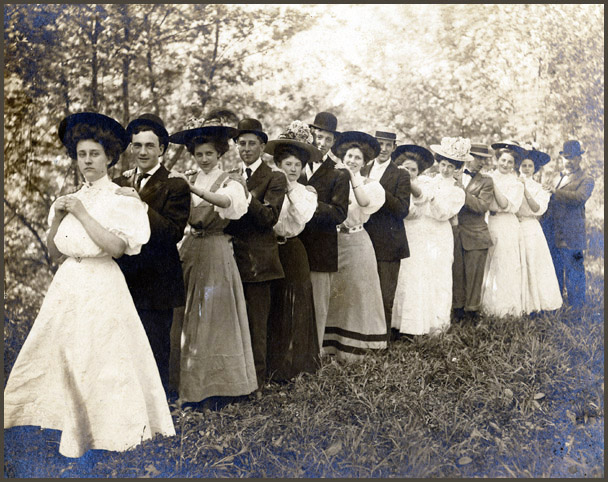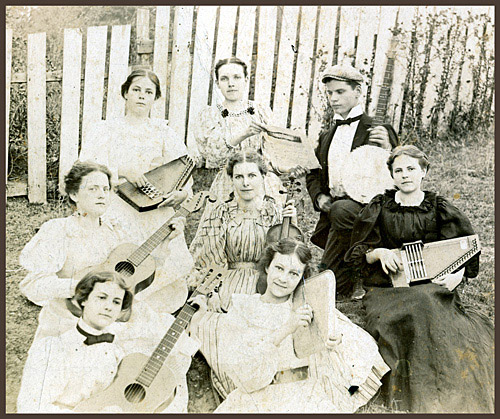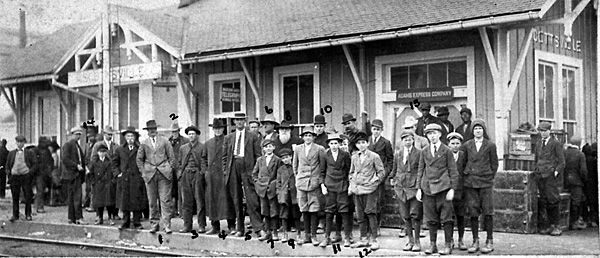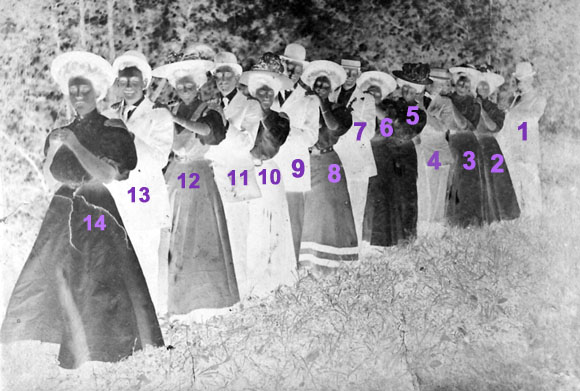

  |
|

|
Name: A Merry Party in Scottsville, 1912 Date: 1912 Image Number: SD12cdSD1 Comments: Merry parties in Scottsville were often held and included dinners,
dances, teas, frolics with games and refreshments. Use the image below as a guide
to the identities of these party-goers (from R to L): To learn more about Scottsville social life during the summers in the early 1900's, please read the following article by Ruth Klippstein, which was published in the Scottsville Monthly in July 2011: Best of All We Were Young" - 19th Century Summers in Scottsville By Ruth Klippstein Scottsville Monthly July 22, 2011 - August 18, 2011 In the early 1900's, Miss Hannah Moore's Hall hosted frequent plays and musical performances, which were an important part of Scottsville social life and great fun. Sam Gault dressed up as 'Old King Cole' for an entertainment at Miss Hannah Moore's Hall on Valley Street. Miss Hannah converted an old brick factory building near her house into a theater where home-grown plays were a rich source of entertainment in Scottsville. For over a decade, Miss Hannah's Hall was a focus for the town's social life. If you wanted to see a movie at Victory Hall Theater on an August afternoon, 1911, twenty cents would buy you a balcony seat--15 cents for children. The Scottsville Enterprise reports there was a "musical Comedy given by Prof. Clifford, the blind musician, which was highly entertaining" late in June 1911. Thomas Ellison Bruce wrote to his sweetheart, Mary Browne, in August, 1915, "There are more lawn parties and 'affairs' going on around through the country than you can 'shake a stick at' and something scheduled for most every night." Summer in Scottsville always brought fun. Early in the twentieth century, as shown in the 1907 photo above, the men about town were wearing wool jackets, pants, neckties, and caps or bowlers, and the women, 90 degrees or not, were in long skirts and tightly-fitted waists, with broad-brimmed hats trimmed with feathers or ribbons. We have glimpses of this front porch-and-hand cranked ice cream time not only from William Burgess photographs, but from the Bruce-Browne "Letters of Courtship," edited by Rebecca Jane Bruce in 1986; and earlier accounts of summer entertainments in Scottsville from the "Algoma Log Book, 1890-1893," edited in 2003 by Mrs. Frederic W. Scott; Fannie Patteson's 1934 "Childhood Days in Scottsville, 1860-1870;" "With Love from Mother," Susan Hill Dunn's ca. 1934 memoir of nineteenth century Scottsville; and John C. Hill's "Recollections of Scottsville, 1870-1886." (All are available in the Local History Corner of the Scottsville Library.) Our earliest information reaches back to the aftermath of the Civil War when as Susan Hill Dunn says, Scottsville and all Southerners "were desperately poor, and proud of our poverty. In spite of hard times, life had its fun and excitement. We had other ways of forgetting the humiliation of our defeat. Parties and get-togethers were many--in small houses and in big. We danced, we flirted, we joked, and generally made light of our poverty. Father (James Christian Hill) was the leading spirit in organizing horse races that everyone attended even though there was no money to bet." Dunn says that "one summer when school closed, the Ellis family invited Susie and Annie Powers, Bessie, Sue Davis and me to go visit them. It was a beautiful time�It was the only place I ever knew where people lived with no visible means of support, yet lived the easiest and pleasantest life imaginable. I have known as many as twenty-five persons to be there for supper, just neighbors dropping in and staying on. We played games, Auction bridge, we danced, we flirted, we went horseback riding, and best of all we were young! No one had any duties to do. It was an enchanted summer." Susan's brother, John Hill, tells us "the old swimming hole was in the James and about opposite the foot of Driver's Hill (the laundromat at Route 6 in Scottsville is there now), where the culvert emptied the waters of the creek into the river. There was a big rock about midway in the river on which we would rest when swimming across�Generally it was a foot or more under water, and hard to find. And if you missed it, that meant a swim all the way across with no breathing spell. This hole, by the way, was usually the starting point for a foray on George Nicholas's watermelon patch." Hill writes that "in 1879 or 1889, a regatta was held on the James River at Maiden's Adventure, not far above Richmond, and that was the occasion of my first ride on the packet-boat. A large delegation from Scottsville, including our entire family, went down for the fun. After the races, we went up on the bluff above the river for a picnic, and to watch a shooting match�" "Up the river, a mile or so," Hill continues, describing Scottsville "there is, or was, quite a sizable island, fairly level and covered with trees. When I was just a youngster, it was almost a community habit to hold a watermelon feast on that island at least once a year. It was always a night affair, and on the full of the moon. Billy Beal, Henry Harris, Willie Wade, Ben Jones, and the older men of the town sponsored the affair. They would hire a flatboat from Ferryman Napier�load it with melons and the young folks of the town, and pole the boat up to the island. Some of the elderly ones went along, too, to act as chaperones, for my mother went once, at least, which accounts for my being there. And what an affair it was! I imagine more than one match was consummated on these outings. Returning home, we just drifted down with the current, singing, laughing, and contentedly happy." Fannie Patteson remembers all the women in Scottsville wearing green veils in summer to shield their skin, recalls a party she attended before the war at a "beautiful farm four miles up the river�A big crowd went in a flat boat up the canal. Core Lewis was much frightened when we went through the lock." The Algoma log book, listing guests and activities at the summer home of General Logan across the James from Howardsville is a first-hand account of genteel life in the 1890's: "a 'parasol brigade' marched on the grounds of the estate to celebrate July 4th"; "there was a little dancing in the evening and then followed the fireworks!" Men and women went horseback riding or fishing and played a lot of tennis. One evening, when men were not present at supper, "Mary & Julia luxuriated in tennis costumes. Danced a little." The family sang, played parlor games, set up tables for whist. Ouija was very popular. The Algoma girls ran a charity tea--the mechanics of it are unexplained--and were happy to raise 65 cents. A decade later in 1914, according to a newspaper account reproduced in Richard Nicholas's "Early History of the United Daughters of the Confederacy, Scottsville," the local UDC raised funds for the marker at Scottsville's Confederate Cemetery by "selling at auction to the highest bidder beautifully decorated lunch boxes filled with the most luxurious dainties, each box containing the name of the lady with whom the purchaser must share his lunch. The chance business did not always allow things to match up as desired by the participants, but worked well to amuse the assembly. In many instances, some fellow could be seen casting an angry eye at another who was enjoying supper with his girl. A very delightful and charming evening was spent�" Moore's Hall was the scene of many Scottsville entertainments before Victory Hall was erected. Hannah Moore was considered "the entertainment entrepreneur of Scottsville" at the turn of the century, according to Bob Spencer, and her building across Mink Creek, at the end of Jefferson Road, beside where Doug's Maytag is now, was "the only place in town large enough to stage any type of entertainment." The building is long-gone, but the legend is well-known," Bob says. On July 13, 1899, there was a minstrel show there featuring the Scottsville String Band, a vocal solo, skits, a "Philosophical Dissertation," and refreshments. Tickets were on sale at Beal Brothers for 15 to 35 cents. Even earlier, John Hill writes enthusiastically about Scottsville's Brannigan's Minstrels, who set up a stage with "wings, footlights, and other accessories" in the old factory building on Valley Street. He found the band good, though "in those far-off days, we did not have any of the fancy instruments common today. The tap dancing� was exceptional. For amateurs, Brannigan's Minstrels put on a good show, at least, everybody thought so at the time."  Home-grown music concerts were much enjoyed entertainment in Scottsville in the early 1900's. Guitars, harpsichords, violins, banjos, and pianos were popular instruments of the day, playing waltz, and two-step dances at local parties and dances. Three musically talented families (Blair, Powers, and Osbornes) gathered for this photo taken in Scottsville circa 1900. Row One (L to R): Nellie Osborne, unidentified lady; Row Two (L to R): Dimp Blair, Lucy Powers, Tempe Osborne; Row Three (L to R): Nita Osborne, Marietta 'Met' Powers, and unidentified young man. In 2011, the Scottsville Museum exhibited a photograph (shown above) of the ca. 1900 "Powers, Osborn, and Blair Musical Group," seven young women with autoharp, guitars, and one fiddle, and a young man on banjo. The accompanying description notes that "Homegrown music concerts were much enjoyed (and) did much to boost the town's morale�in the face of challenging economic times and a decline in population." Plays and tableaux vivants were also popular entertainments. The Scottsville High School offered a class play yearly, often at Victory Hall; June, 1924 saw Russell Moon, Ruby Fenwick, and other Seniors in "Nothing but the Truth." John Hill recalls, in the 1880's, the best tableau was "Bluebeard's Wives, a gruesome scene showing the heads of seven (or nine) wives. The girls stood behind a large white canvas screen. Gobs of red ink, simulating blood, ran down from each head, making a gory picture. Strange to say, the only heads I remember are those of Annie Farrar and Fannie Patteson. Then there was the tableau, "Rock of Ages," showing Ada Nicholas clinging to the cross, her black hair streamed down below the waist-line�. "I always did think she was about the sweetest thing the Lord ever created�." Susan Hill Dunn recalls the "ambitious entertainments, scenes from Shakespeare, from Rip van Winkle, from art and poetry" staged by the Principal of the school, Mr. McDonald, when she was ten. "May Davis was Marie Stuart, and the second tableau showed her body on one side of the executioner's block and her head on the other, an easy arrangement by using two people, but very thrilling we thought." Baseball entertained Scottsville in the summer for years. There was a field in what is now Dorrier Park, behind the old post office building, the high school team played there, as well as the older men. Hill called the town team, "The Greenhorns, the finest amateur club in the State." Bob Spencer says the field and grandstand, with the first rows protected from foul balls by chicken wire, lasted into the late '40's at least. Thomas Ellison Bruce often attended games and wrote in detail of them to his fianc�e in Palmyra; like many fans, he enjoyed the good season of 1913 but not the losing record the next year. Picnics often entertained groups in Scottsville. In June 1914, Bruce writes of one with "an immense crowd and My! What we had to eat!" Bruce points out to Mary what she's missing: "Everything is real lively up here, something going on most every night. A goodly number of visiting summer girls are in the community." Pauline Parr received a letter from a friend in May, 1925 (now archived in the Omohundro box in Special Collections at the University of Virginia) urging her to come to a "supper in the grove," bringing her squire, Ashby, and promising "we'll have good old strawberry ice cream, sandwiches, ice tea and cake." By the early 1920's, cars and better roads changed summer entertainment for the older young people of Scottsville. Pauline and Ashby took a drive one evening on "the new concrete road to Carter's Bridge." But prayer meetings and other church activities were still important places for the young to gather, and movies, visiting friends, knitting, and dances are mentioned in a journal included in the Omohundro collection.  The James River Division of the Chesapeake and Ohio, built in 1881, was of great importance to Scottsville as it hauled freight, passengers, and the daily mail to town. A purely Scottsville amusement in the early 1900's was watching the train go by. As shown here, it was common to see a good-sized group of townsfolk strolling down to the depot with Postmaster Gault to meet the Number 11 from Richmond and pick up the day's mail. A special Scottsville entertainment was "going to the train." John Philip Randolph writes about it in "Of Town and the River"--"in the summertime anyway, a pretty good representation (of people) gathered at the depot to meet the evening Accommodation No. 11 from Richmond, listening to the Londeree brothers singing in harmony." In his oral history interview dated 1987, Dr. Paul McFarland says, "Well the mail was the big thing, you know. Oh, heavens, yes, that was the social event of the day." People walked with the postal clerk carrying the mail to the post office, on Main Street at the corner of Valley, waited while the mail was sorted. "And everybody'd go to their boxes, get to the window, and get their mail�.And in ten or fifteen minutes most of the lights were cut, everybody gone, and the town was dead." Perhaps, however, some young people lingered on the porch swing, courting. Susan Dunn tells of meeting her future husband around 1890 when he came on a business errand to her father one June day, "all of us talking and fanning on the porch. We all started dropping things and the poor young man was so polite and agile in picking them up� We liked the same books, we had the same tastes, we wondered at the same mysteries�To understand us, you would have to reconstruct your world. Scottsville was almost primitive in simplicity of life. What did we do? First came books and long conversations about all the things thoughtful young people always have wondered and dreamed about� We drifted through another enchanted summer (before marrying). How lovely to store up memories for days to come!" Remembering summer when "best of all we were young." This summer (2011), Lang Mason is preparing a new production for Victory Hall Theater to continue the long line of Scottsville theatricals: Tennessee Williams' "Suddenly Last Summer." It will be shown on September 2-11, 2011, on weekends. Come see it and add to your own Scottsville memories! Copyright © 2020 by Scottsville Museum |

|
|
|
Museum
Burgess
Business
Cemeteries
Church
Events
Floods
For Kids
Homes
Portraits
Postcards
School
Transportation
Civil War WWII Esmont Search Policy |
||||
|
Scottsville Museum · 290 Main Street · Scottsville, Virginia 24590 · 434-286-2247 www.avenue.org/smuseum · [email protected] Copyright © 2020 by Scottsville Museum |
||||